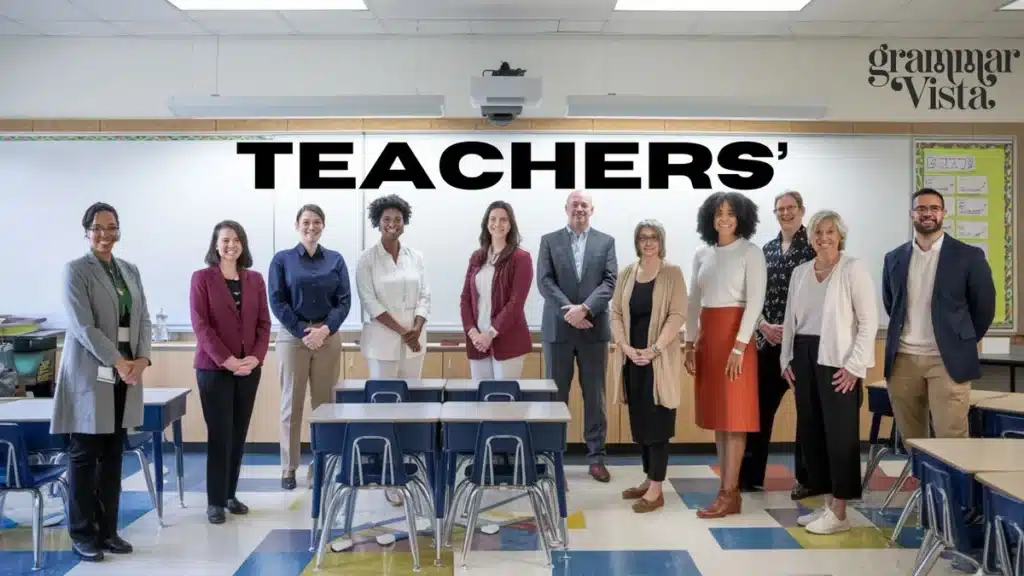Have you ever stared at a word, wondering whether to add an apostrophe and if so, where? You’re not alone. It is a common issue that everyone has to face. No worries, just read this article till end and get everything clear. Today, we’ll dive deep into one of English grammar’s most confusing aspects: possessive forms. Let’s unpack the mystery behind singular possessive form and plural possessive form using “teacher” as our guide to language mastery. If you really want to understand the difference among these possessives Teacher’s, Teachers’, or Teachers, don’t skip the enlisted points!
The Fundamental Rules of Possession
Before we tackle specific examples, let’s establish some ground rules for clear communication. Think of apostrophes as tiny signposts pointing to ownership. Their placement can completely change a sentence’s meaning, affecting our educational approach to grammar.
Singular Possessive (Teacher’s)

When we’re talking about one teacher owning something, we add ‘s:
- The teacher’s desk (one teacher owns the desk)
- The teacher’s lesson plan (one teacher owns the plan)
- The teacher’s coffee mug (one teacher owns the mug)
Plural Possessive (Teachers’)

When multiple teachers own something collectively, we add the apostrophe after the s:
- The teachers’ lounge (a lounge for all teachers)
- The teachers’ parking lot (a lot for all teachers)
- The teachers’ supply closet (a closet used by all teachers)
Standard Plural (Teachers)

Sometimes we just need the plural form without showing possession:
- The teachers went on strike
- The teachers attend monthly meetings
- The teachers collaborate on projects
Real-World Scenarios:
Let’s explore some practical situations where understanding these distinctions supports professional development and helps in sharpening skills.
Scenario 1: The School Environment
- “I left my book in the teacher’s lounge” (incorrect – it’s a shared space)
- “I left my book in the teachers’ lounge” (correct – it belongs to all teachers)
Scenario 2: Personal Belongings
- “The teacher’s laptop stopped working” (one teacher’s device)
- “The teachers’ laptops were all upgraded” (multiple teachers received upgrades)
Complex Cases: When Multiple Possessives Collide
According to expert insights, some situations require extra attention:
Joint Possession
- “Mr. Smith and Mrs. Jones’s classroom” (they share one room)
- “Mr. Smith’s and Mrs. Jones’s classrooms” (separate rooms)
Compound Structures
When dealing with a physical part of something:
- “The teacher’s aide’s notebook” (the notebook belongs to the aide)
- “The teachers’ union’s decision” (the decision belongs to the union of teachers)
Common Mistakes and How to Avoid Them
Understanding these rules enhances our language mastery and helps prevent common errors:
Mistake 1: Confusing Plurals with Possessives
❌ “The teacher’s are meeting today” ✓ “The teachers are meeting today”
Mistake 2: Misplaced Apostrophes
❌ “The teachers lounge” ✓ “The teachers’ lounge”
Read More about Business’ or Business’s?
The Psychology Behind Possessive Forms
Understanding possessives isn’t just about rules, it’s about conveying meaning through clear communication. Let’s explore deeper aspects that demonstrate true language mastery.
Cultural and Professional Contexts
Different professional settings require precise understanding of possessives for effective professional development:
Academic Setting Examples
- The teacher’s syllabus (individual ownership)
- The teachers’ conference room (shared space)
- The teachers gathering (no possession, just plural)
Digital Learning Environment
- The teacher’s online portal (individual access)
- The teachers’ virtual meeting space (collective platform)
- The teachers adapting to remote learning (plural action)
Advanced Possessive Structures
Let’s examine complex scenarios that challenge even experienced writers:
Multiple Levels of Possession
- The teacher’s student’s homework
- The teachers’ union’s president’s office
- The teacher’s department head’s assistant’s schedule
These nested possessives show how expert insights can help navigate complicated grammatical structures.
Special Cases and Exceptions
Time-Related Possessives
- One day’s notice
- Two weeks’ vacation
- A semester’s worth of work
The educational approach to these cases requires special attention because they don’t follow standard patterns.
Digital Communication and Possessives

Modern communication brings new challenges:
Email Subject Lines
- Teachers’ Meeting Minutes (for all teachers)
- Teacher’s Performance Review (individual)
- Teachers Professional Day (no possession)
Social Media Usage
- #TeachersLife (no apostrophe in hashtags)
- Teacher’s Perspective (individual blog)
- Teachers’ Resources (shared materials)
Practical Applications in Educational Settings
The Teachers’ Room
Understanding the physical part of school spaces:
- The teachers’ cafeteria
- The teacher’s personal cabinet
- The teachers’ collaborative workspace
Professional Documentation
- The teacher’s portfolio (individual)
- The teachers’ curriculum guide (shared)
- The teachers implementing new strategies (plural action)
International English Variations
Different English-speaking countries might handle possessives slightly differently, affecting language mastery:
British English Examples
- The staff’s quarters (collective singular)
- The teachers’ common room
- The head teacher’s office
American English Examples
- The faculty’s lounge
- The teachers’ parking lot
- The educator’s handbook
Technology and Modern Teaching
In the digital age, possessives appear in new contexts:
Online Learning Platforms
- The teacher’s dashboard (individual)
- The teachers’ resource library (shared)
- The teachers navigating virtual classrooms (plural)
Complex Organizational Structures
Departmental Possession
- The English teachers’ department head
- The science teacher’s laboratory
- The teachers’ break room supervisor
The Impact on Student Learning
When sharpening skills in grammar:
Student Understanding
- The teacher’s explanation (from one teacher)
- The teachers’ collective approach (from all teachers)
- The teachers modifying their methods (plural action)
Professional Growth and Development

For ongoing professional development:
Resource Management
- The teacher’s personal materials
- The teachers’ shared resources
- The teachers attending workshops
Standard Operating Procedures
Every school has its own system for the supply closet and other shared spaces:
Access and Organization
- The teacher’s personal storage
- The teachers’ communal supplies
- The teachers organizing materials
Future Trends in Educational Grammar
As education evolves, so does our understanding of possessives:
Digital Integration
- The teacher’s online presence
- The teachers’ virtual community
- The teachers adapting to change
Practical Tips for Daily Usage
To maintain clear communication:
Quick Reference Guide
- Single owner = ‘s
- Multiple owners = s’
- No ownership = just s
Common Scenarios Solved
Let’s address frequent situations:
School Events
- The teacher’s class presentation
- The teachers’ appreciation week
- The teachers planning activities
You might be interested in Beauty’s, Beauties’, and Beauties
Mastering Contextual Applications
Understanding context transforms basic language mastery into practical expertise. Let’s explore more nuanced scenarios that showcase the importance of proper possessive usage.
Administrative Documentation
The following examples demonstrate how possessives affect official paperwork:
Personnel Files
- The teacher’s employment record (individual file)
- The teachers’ attendance records (group statistics)
- The teachers submitting paperwork (action, no possession)
Digital Age Considerations
Modern teaching brings new possessive challenges:
Online Platforms
- The teacher’s virtual classroom setup
- The teachers’ shared digital resources
- The teachers creating content (plural action)
Specialized Teaching Environments
Different educational settings require unique possessive applications:
Special Education
- The teacher’s individualized approach
- The teachers’ collaborative strategies
- The teachers implementing accommodations
Assessment and Evaluation
Proper possessive usage in grading contexts:
Grading Systems
- The teacher’s rubric (individual assessment tool)
- The teachers’ grading policy (departmental standard)
- The teachers reviewing submissions (plural action)
Parent-Teacher Communication

Clear possessive usage enhances clear communication with families:
Conference Scenarios
- The teacher’s feedback form
- The teachers’ meeting schedule
- The teachers welcoming parents
Professional Learning Communities
Supporting professional development through proper grammar:
Collaborative Learning
- The teacher’s research project
- The teachers’ study group
- The teachers sharing best practices
Educational Leadership
Understanding hierarchical possessives:
Administrative Relationships
- The principal’s directive to the teacher’s department
- The teachers’ union’s response
- The department head’s teacher’s assistant
Physical Space Management
Proper labeling of school spaces supports organization:
Room Designations
- The teacher’s desk arrangement
- The teachers’ workroom
- The teachers utilizing space
Curriculum Development
Possessives in planning and instruction:
Lesson Planning
- The teacher’s unit plan
- The teachers’ curriculum map
- The teachers developing assessments
Technology Integration
Modern teaching tools require precise possessive usage:
Digital Resources
- The teacher’s online portfolio
- The teachers’ shared drive
- The teachers mastering technology
Student Support Services
Coordination of support requires clear possession markers:
Support Programs
- The teacher’s intervention plan
- The teachers’ resource bank
- The teachers coordinating services
Professional Organizations
Understanding organizational possessives:
Association Membership
- The teacher’s professional dues
- The teachers’ association meetings
- The teachers networking professionally
Emergency Procedures
Clear ownership in crisis management:
Safety Protocols
- The teacher’s emergency folder
- The teachers’ evacuation plan
- The teachers practicing procedures
Future Educational Trends
Possessives in emerging educational practices:
Innovation
- The teacher’s experimental method
- The teachers’ pilot program
- The teachers embracing change
Specialized Areas
Different subject areas have unique possessive needs:
Subject-Specific Examples
- The art teacher’s supply list
- The science teachers’ lab protocol
- The math teachers calculating budgets
International Teaching
Global education contexts:
Cultural Considerations
- The ESL teacher’s methodology
- The teachers’ cultural exchange
- The teachers bridging differences
Professional Ethics
Ethical considerations in possessive usage:
Confidentiality
- The teacher’s private notes
- The teachers’ confidential records
- The teachers maintaining privacy
Community Engagement
Possessives in community relations:
Outreach Programs
- The teacher’s community project
- The teachers’ volunteer program
- The teachers building connections
Educational Research
Academic writing requires precise possessive usage:
Research Activities
- The teacher’s action research
- The teachers’ collective data
- The teachers publishing findings
Conclusion
This comprehensive guide demonstrates how proper understanding of possessives enhances both clear communication and professional development. Whether managing a supply closet or developing educational approaches, proper possessive usage remains crucial for effective teaching and learning.
Remember that mastering these distinctions supports both individual growth and collective progress in education. Through careful attention to these details, we can maintain professional standards while fostering effective communication in all educational contexts.
Read More grammar lessons on GrammarVista







